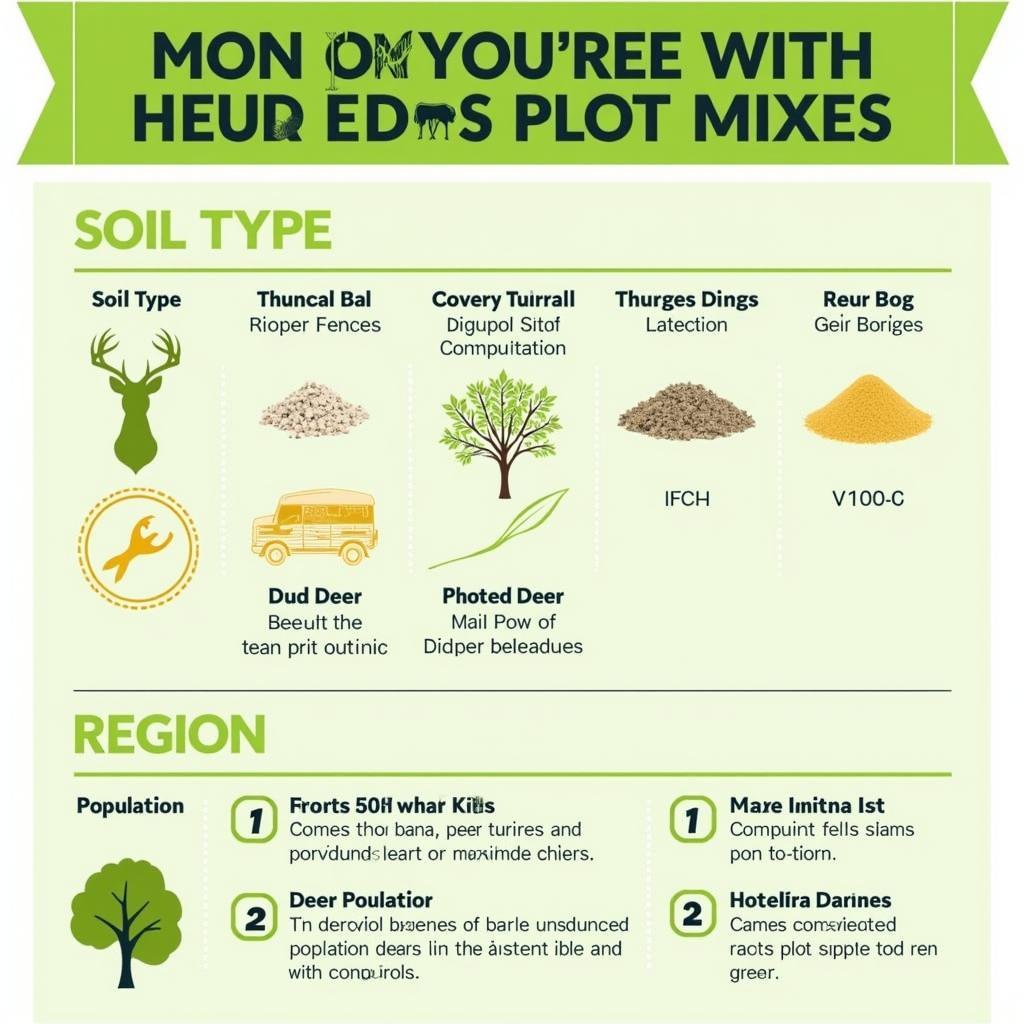Choosing the Best Deer Food Plot Mixes for your property can make all the difference in attracting and holding deer throughout the hunting season. But with so many options available, it can be overwhelming to know where to start. This comprehensive guide will walk you through everything you need to know about selecting, planting, and maintaining the ideal food plot mixes to keep those whitetails coming back for more.
Understanding Deer Nutritional Needs
Before diving into specific seed mixes, it’s crucial to understand the nutritional needs of deer throughout the year. Deer are ruminants, meaning they have a four-chambered stomach that allows them to digest tough plant matter. However, their dietary needs change depending on factors like season, temperature, and available forage.
Spring and Summer: During these months, deer focus on consuming high-protein foods to support antler growth and fawn development. Look for mixes containing legumes like clover, alfalfa, and peas.
Fall and Winter: As temperatures drop, deer require high-energy foods to maintain body heat and prepare for the breeding season. Consider mixes with brassicas like turnips, radishes, and rape, along with grains like oats and winter wheat.
Factors to Consider When Choosing Deer Food Plot Mixes
 Factors to consider when choosing deer food plot mixes infographic.
Factors to consider when choosing deer food plot mixes infographic.
- Region: Different plant species thrive in different climates. Make sure to select a mix that is well-suited to your region’s growing conditions.
- Soil Type: Soil pH and nutrient levels will significantly impact the success of your food plot. Conduct a soil test to determine the appropriate amendments and choose mixes that align with your soil type.
- Sunlight: Evaluate the amount of sunlight your plot receives throughout the day. Some plants require full sun, while others can tolerate shade.
- Deer Population: The size and density of the local deer population will influence the amount of food needed to sustain them. A larger herd may require larger plots or more frequent replanting.
- Budget: Food plot seed mixes vary in price depending on the seed varieties and bag size. Determine your budget and choose a mix that provides the best value for your needs.
Popular Deer Food Plot Mixes
1. Clover and Chicory Mixes
A classic choice for a reason, clover and chicory mixes provide a long-lasting source of nutrition for deer throughout the year. Clover offers high protein content, while chicory adds a touch of sweetness and can withstand heavy grazing pressure.
2. Brassica Blends
 A farmer scattering brassica blend seeds in a food plot.
A farmer scattering brassica blend seeds in a food plot.
Perfect for fall and winter, brassica blends include nutrient-rich plants like turnips, radishes, and rape. These cold-hardy vegetables offer excellent attraction power and provide deer with essential carbohydrates and vitamins during the colder months.
3. Bean and Pea Mixes
For a protein-packed punch, consider planting a mix of beans and peas. These legumes attract deer with their sweet taste and offer high levels of protein, crucial for antler development and fawn growth.
4. Grain and Cereal Rye Mixes
Provide deer with a source of energy during the winter months with a mix of grains and cereal rye. Oats, wheat, and rye offer digestible carbohydrates that help deer maintain body heat and navigate the challenges of winter.
Tips for Successful Food Plot Management
- Proper Soil Preparation: A well-prepared seedbed is crucial for successful germination and plant establishment. Test your soil, amend as needed, and ensure proper drainage.
- Planting at the Right Time: Pay close attention to recommended planting dates for your chosen seed mix and region. Planting too early or late can significantly impact the success of your plot.
- Weed Control: Keep weeds at bay to prevent competition for resources and ensure your food plot thrives. Consider using herbicides or implementing weed control practices like mulching or hand-weeding.
- Monitor and Replenish: Regularly inspect your food plot for signs of overgrazing or nutrient depletion. Consider overseeding or adding fertilizer to maintain a healthy and attractive food source for your deer herd.
“Remember,” says wildlife biologist Dr. Sarah Jones, “a well-maintained food plot not only attracts deer but also contributes to their overall health and well-being. By understanding their needs and providing them with essential nutrients, you’re playing a vital role in supporting a healthy deer population.”
Conclusion
Creating the best deer food plot mixes requires careful planning and consideration, but the rewards are well worth the effort. By understanding deer nutritional needs, selecting the appropriate seed mixes for your region, and implementing proper management techniques, you can create a haven for whitetails and enjoy a successful hunting season.
Ready to get started? Check out our selection of fall deer food plot seed mixes and find the perfect blend for your property.